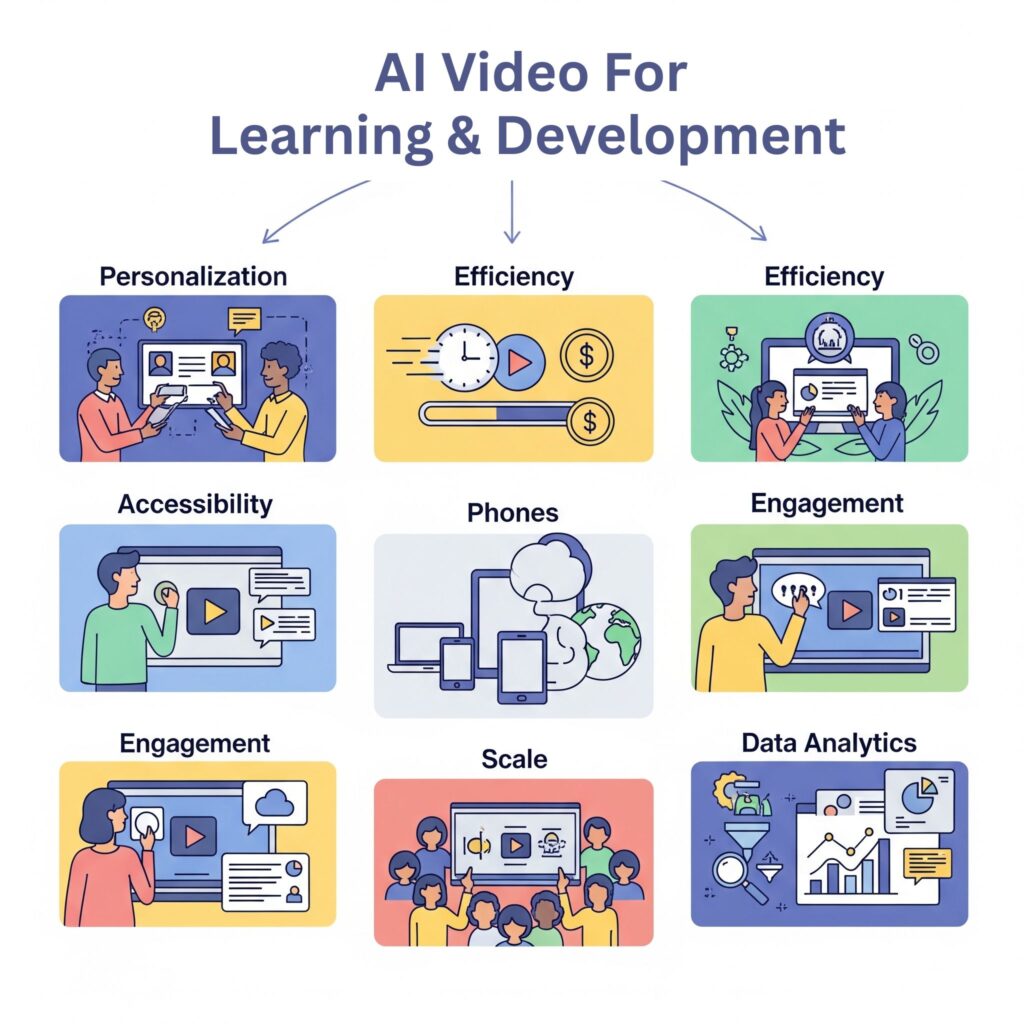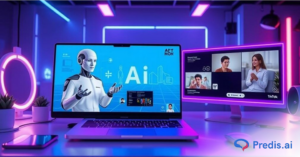Let’s be honest, Learning & Development teams today are under pressure. Engagement in corporate training is dipping, budgets are shrinking, and scaling high-quality learning content across different roles, regions, and languages feels harder than ever. Traditional training methods can’t always keep up with the pace of modern workplaces, leaving both employees and trainers frustrated.
This is where AI Video for Learning & Development steps in. Unlike traditional video learning, AI-driven video uses technologies like text-to-speech, digital avatars, automation, and personalization to deliver training that is faster to create, easier to scale, and more engaging for learners. It turns what used to be a lengthy, expensive video production into an agile tool that adapts to diverse audiences and evolving training needs.
In this blog, we’ll explore why AI Video for Learning & Development is the perfect fit for modern organizations. You’ll learn about its key benefits, see real-world use cases, understand the challenges to watch out for, and get practical steps on how to implement it effectively. By the end, you’ll know exactly how AI video can transform your L&D strategy into something cost-effective, scalable, and impactful.
TL;DR 🖋
Training teams today face major challenges: low engagement, high costs, and difficulty scaling content across roles and regions. AI Video for Learning & Development offers a solution by making training personalized, interactive, and easy to produce. This blog explores its benefits, real-world use cases, implementation tips, and potential pitfalls to help L&D leaders adopt AI-powered video effectively.
Key Takeaways:
- Personalized Learning
- Cost & Time Efficiency
- Accessibility
- Engagement & Retention
- Scale vs Quality
- Real-World Use Cases
- Implementation Steps
What Is AI Video for Learning & Development?
Traditional e-learning videos have always played a role in training, but they come with limitations. They take time to produce, require professional equipment and editing, and once created, they’re difficult to update or personalize. That’s where AI Video for Learning & Development changes the game. By using artificial intelligence, organizations can create training content that is faster to produce, easier to update, and tailored to individual learning needs.

AI-powered video brings in elements that traditional video can’t match:
- Avatars that act as virtual trainers or role-players in scenarios.
- Voice synthesis that generates natural-sounding narrations in multiple languages.
- Automated editing that cuts production time from weeks to minutes.
- Real-time feedback and analytics that measure learner engagement.
- Interactivity that makes learners active participants instead of passive viewers.
So why call it AI Video for Learning & Development instead of just “video training”? Because AI adds personalization, scalability, and adaptability at a level that traditional video simply can’t. Instead of one-size-fits-all training, AI makes it possible to deliver content that feels relevant to every learner, across roles, departments, and regions, all without skyrocketing costs or production time.
How AI Video for Learning & Development Transforms Training Content?
The real power of AI Video for Learning & Development lies in how it reshapes training content into something more learner-focused, efficient, and impactful.

Here’s how it makes the difference:
1. Personalization
One of the biggest shortcomings of traditional training is its one-size-fits-all approach. Everyone receives the same material, regardless of role, prior knowledge, or pace of learning.
AI video turns that model on its head. It can adjust the content based on learner needs, preferred formats, and specific career goals. For example, an onboarding video for sales teams might focus on product positioning and client engagement, while an engineering onboarding module highlights workflows, safety, or compliance. AI systems can also analyze learner performance and serve up adaptive modules, ensuring that employees don’t waste time on what they already know and instead focus on areas that need improvement.
This level of personalization makes the content more relevant, which leads to higher engagement, better skill retention, and ultimately better business outcomes.
2. Cost & Time Efficiency
Producing training videos traditionally has been slow, expensive, and resource-heavy. Storyboarding, scripting, shooting, editing—it could take weeks or even months, eating up significant portions of L&D budgets. With AI video, processes like script-to-video conversion, voiceover generation, and subtitling are automated.
AI automates much of this process. Tools can convert text scripts directly into videos with lifelike voiceovers, subtitles, and even animated AI avatars. Updates can be rolled out almost instantly, keeping training fresh and aligned with new policies, technologies, or market changes.
The result: what once took months now takes hours, at a fraction of the cost. This shift allows companies to scale training while keeping budgets lean.
3. Accessibility
Modern workplaces are global and diverse. Employees may be spread across time zones, speak different languages, and work on different devices. Traditional training struggles to bridge these gaps.
AI video makes training more inclusive. It can automatically translate scripts into multiple languages, generate captions, and optimize playback for mobile, desktop, or even low-bandwidth environments, and complement additional learning materials such as reading worksheets for enhanced accessibility. Employees no longer have to wait for in-person sessions—they can access training whenever and wherever they need it.
This inclusivity doesn’t just help global teams. It also supports employees with different learning abilities, ensuring that no one is left out of critical training
4. Enhanced Engagement & Retention
Features like clickable scenarios, AI avatars, and microlearning modules help learners stay engaged and, more importantly, retain what they’ve learned. Studies consistently show that interactive and personalized content significantly improves memory recall and application on the job.
AI video solves this problem with dynamic, interactive formats. Learners can engage with branching scenarios, answer quiz questions inside the video, or follow story-driven microlearning modules. AI avatars and contextual animations also make content feel less like a lecture and more like a guided conversation.
5. Scale Vs Quality
Traditionally, scaling up training has meant sacrificing quality. Either you produce high-quality videos for a limited audience, or you produce generic materials for everyone.
AI removes this trade-off. It enables organizations to quickly create and distribute training content at scale while maintaining a high level of polish. Whether rolling out compliance updates to thousands of employees or delivering role-specific modules across different regions, AI ensures speed without compromising learner experience.
6. Learner-Centric Experience
AI video puts the learner in control. Instead of forcing everyone through rigid, hour-long sessions, content can be delivered in bite-sized, modular formats. Employees can learn at their own pace, revisit tricky sections, or skip topics they already know.
This flexibility is crucial in modern workplaces, where employees juggle multiple responsibilities. Training no longer feels like an interruption, it becomes something that fits seamlessly into daily routines. And when learning feels accessible and manageable, completion rates and knowledge application naturally improve.
7. Reduced Learning Time
Complex concepts are often difficult to explain through text-heavy presentations or static slides. AI video simplifies them through visuals, narration, and adaptive explanations.
For instance, an AI-generated explainer video can visually break down a complicated workflow, use voiceover to guide learners step by step, and adapt based on learner input. This combination speeds up comprehension and shortens the overall learning curve. Organizations benefit by reducing the time employees spend in training while accelerating the time it takes to apply new knowledge on the job.
8. Real-Time Feedback & Analytics
Perhaps the most powerful advantage of AI in L&D is data. Traditional training often leaves managers guessing about effectiveness. Did employees actually learn anything? Are they applying it?
AI video changes this. Built-in analytics track who completed training, how engaged they were, where they dropped off, and how they performed in assessments. This feedback loop helps L&D teams continuously refine content for maximum impact. Managers can also use this data to identify skill gaps, measure ROI, and personalize further training.
Check Out The Real-World Use Cases
Understanding the potential of AI Video for Learning & Development is easier when you see it in action. From onboarding new hires to upskilling employees and delivering compliance training, AI-powered video is transforming how organizations train and engage their workforce.
1. Induction & Onboarding
What it is: Induction and onboarding are the first steps in introducing new hires to an organization. This process includes familiarizing them with company culture, policies, tools, and workflows.
How AI Video can be used for Learning & Development:
AI video allows organizations to create personalized onboarding content for different roles, locations, or departments. Digital avatars can guide new employees through interactive modules, explain workflows, and answer frequently asked questions automatically. Voice synthesis and subtitles make the content accessible in multiple languages, and updates can be rolled out instantly as processes change.
Example:
A global company uses AI video to onboard sales teams in different countries. Each module introduces regional processes, team structures, and compliance requirements in the local language, ensuring employees feel immediately informed and connected.
2. Compliance Training
What it is: Compliance training ensures that employees understand and adhere to laws, regulations, and company policies. This is critical in industries like finance, healthcare, and manufacturing.
How AI Video can be used for Learning & Development:
AI-powered video can deliver compliance content with localized language options, captions, and culturally relevant examples. Interactive AI avatars can simulate real-world scenarios, helping employees understand the consequences of non-compliance and engage actively with the material.
Example:
A multinational bank uses AI video to train employees on anti-money laundering rules or AML case investigation process. Employees in different regions receive localized training, complete with scenario-based simulations, quizzes, and real-time feedback on performance.
3. Upskilling & Technical Training
What it is: Upskilling focuses on improving employees’ existing skills, while technical training equips them with new technical knowledge required for their roles.
How AI Video can be used for Learning & Development:
AI video breaks down complex technical topics into digestible visual explanations. Voice synthesis narrates processes, and interactive diagrams or simulations allow learners to practice skills in a controlled environment. Personalized paths can adapt based on learner progress, ensuring efficient comprehension.
Example:
A software company uses AI video to train developers on a new programming framework. Interactive modules demonstrate code workflows visually, while avatars guide learners through exercises, and AI tracks progress to suggest areas for review
4. Soft Skills Training
What it is: Soft skills training focuses on interpersonal and communication skills, such as leadership, negotiation, teamwork, and problem-solving.
How AI Video can be used for Learning & Development:
AI avatars simulate realistic workplace interactions, role-play difficult conversations, or create branching scenarios. Employees can practice communication and decision-making in safe, realistic virtual environments, receiving feedback based on their choices.
Example:
A customer service team uses AI video to practice conflict resolution. Employees interact with AI avatars representing challenging customers, making choices in real time and receiving instant feedback on their responses, helping them build confidence and refine techniques.

How to Implement AI Video for Learning & Development Successfully?
Implementing AI Video for Learning & Development effectively requires a structured approach. By following these steps, organizations can maximize the impact of AI-powered training while avoiding common pitfalls.

Step 1: Define Learning Objectives & Audience
Before creating any content, it’s crucial to understand who your learners are, what skills or knowledge they need, and where the gaps lie. Clearly defined objectives ensure that AI video content aligns with organizational goals and delivers measurable value.
Step 2: Choose the Right AI Video Tools or Vendors
Not all AI video platforms are created equal. When selecting a tool, consider factors such as language support, voice quality, flexibility in editing, ease of creating interactive content, and built-in analytics. The right platform should support your current and future training needs — especially for teams working on custom web application development, where clear technical training is essential.
Step 3: Start with Pilots or Small Projects
Rather than rolling out AI video across the entire organization at once, start with a pilot program. Test a few modules, gather feedback from learners, and iterate based on results. This approach minimizes risk and ensures that the final content is engaging and effective.
Step 4: Create a Content Plan for Updates and Modular Reuse
AI video makes it easy to update content, but planning ensures efficiency. Structure your training in modular chunks that can be reused across roles, departments, or regions. This reduces duplication, simplifies updates, and allows you to scale quickly.
Step 5: Measure Outcomes
The final step is to track performance. Use analytics to measure engagement, retention, and time to competence. Assess cost savings and identify areas for improvement. Continuous measurement ensures your AI video strategy evolves with your learners’ needs and delivers maximum impact.
Conclusion
AI Video for Learning & Development is quickly becoming a near-perfect solution for modern L&D challenges. It combines personalization, scalability, and interactivity, making training more engaging, accessible, and effective. Organizations can deliver content faster, update it easily, and track learner outcomes in real time, all while reducing costs and improving knowledge retention.
Key Takeaways:
- AI video enables personalized, learner-centric training that adapts to different roles and learning styles.
- It dramatically improves engagement and retention through interactive, visually rich content.
- Cost and time efficiencies allow organizations to scale training without sacrificing quality.
- Consider potential challenges like over-automation, maintaining brand voice, and data privacy when implementing AI video.
- Start small with pilot programs, measure results, and iterate for continuous improvement.
















